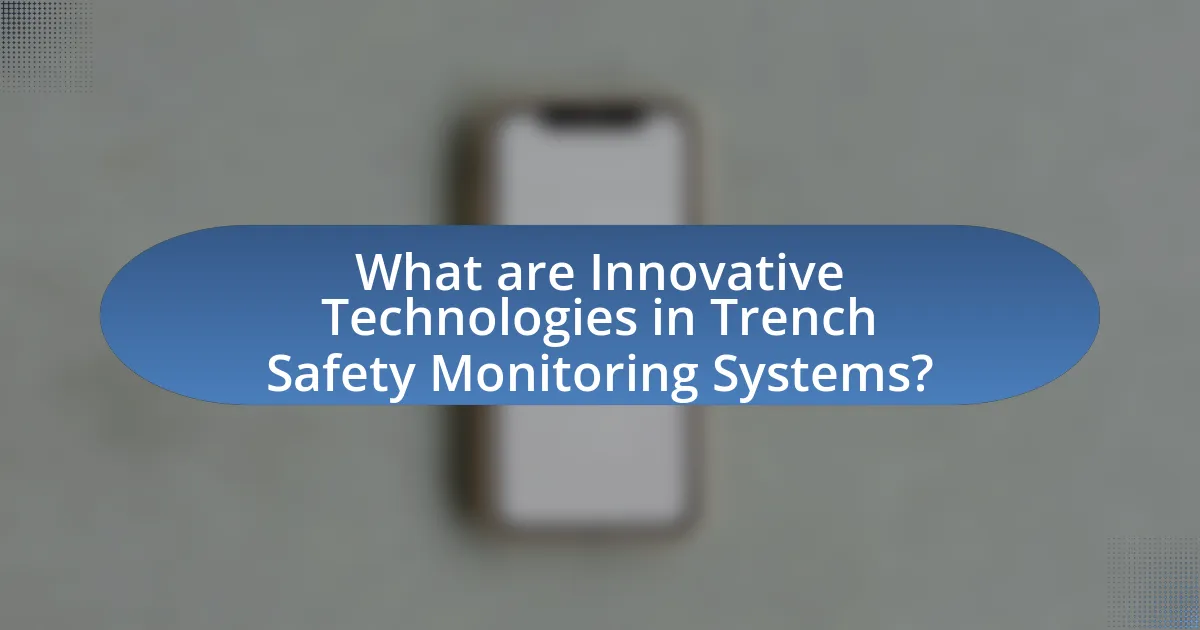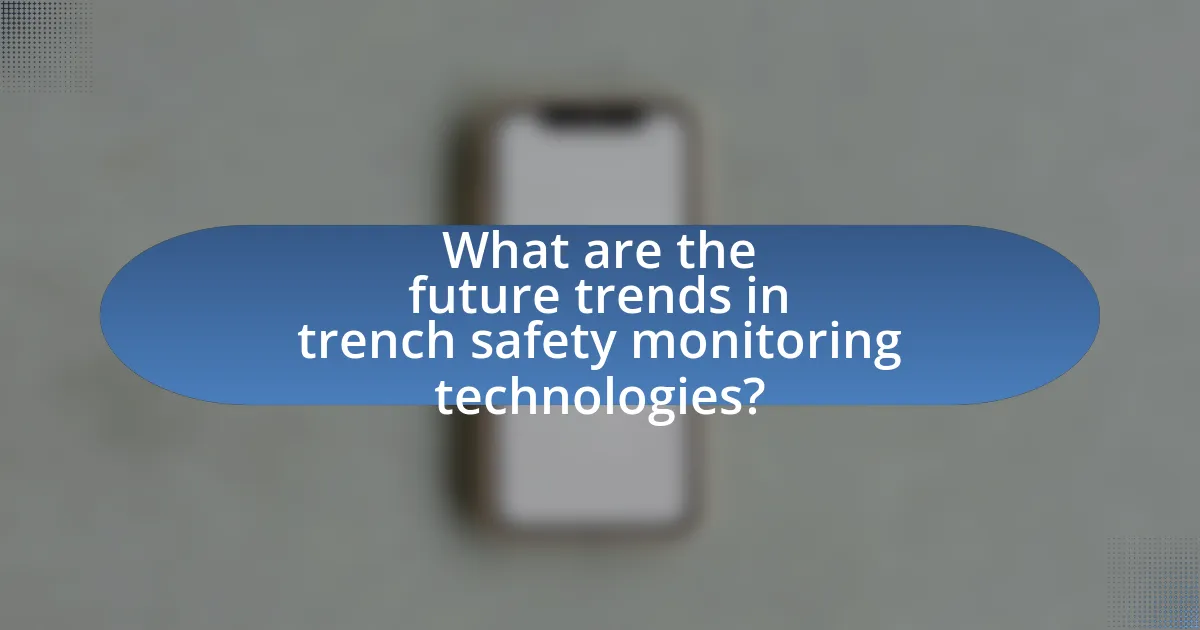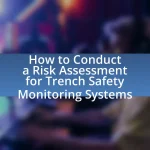Innovative technologies in trench safety monitoring systems play a crucial role in enhancing worker safety during excavation operations. These technologies include real-time monitoring sensors, automated alert systems, and advanced data analytics platforms that collectively improve safety measures and compliance with regulations. Key risks addressed by these systems encompass cave-ins, hazardous atmospheres, and equipment-related accidents, with studies indicating that their implementation can significantly reduce trench-related incidents. The article explores the specific technologies utilized, such as ground-penetrating radar and IoT sensors, and discusses the importance of regular training and maintenance practices to ensure the reliability and effectiveness of these safety systems.

What are Innovative Technologies in Trench Safety Monitoring Systems?
Innovative technologies in trench safety monitoring systems include real-time monitoring sensors, automated alert systems, and advanced data analytics platforms. Real-time monitoring sensors, such as soil pressure sensors and vibration monitors, provide continuous data on trench conditions, allowing for immediate detection of potential hazards. Automated alert systems notify workers of unsafe conditions through alarms or mobile notifications, enhancing response times. Advanced data analytics platforms analyze collected data to predict risks and improve safety protocols, leading to a reduction in trench-related accidents. These technologies collectively enhance safety measures and compliance with regulations in excavation work.
How do these technologies enhance safety in trench operations?
Innovative technologies enhance safety in trench operations by providing real-time monitoring and predictive analytics to prevent accidents. For instance, trench safety monitoring systems utilize sensors to detect soil movement, water accumulation, and structural integrity, allowing for immediate alerts to workers and supervisors. According to a study published in the Journal of Safety Research, the implementation of such technologies has been shown to reduce trench-related accidents by up to 30%, demonstrating their effectiveness in enhancing safety protocols.
What specific risks do trench safety monitoring systems address?
Trench safety monitoring systems specifically address risks such as cave-ins, hazardous atmospheres, and equipment-related accidents. Cave-ins pose the most significant risk, with the Occupational Safety and Health Administration (OSHA) reporting that they account for the majority of trench-related fatalities. Hazardous atmospheres, including the presence of toxic gases or insufficient oxygen, can lead to serious health risks for workers. Additionally, equipment-related accidents, such as those involving heavy machinery operating near trenches, can result in injuries or fatalities. These systems utilize sensors and real-time monitoring to detect changes in soil conditions, gas levels, and equipment proximity, thereby enhancing worker safety and compliance with safety regulations.
How do innovative technologies improve risk assessment in trenches?
Innovative technologies improve risk assessment in trenches by utilizing advanced monitoring systems that provide real-time data on environmental conditions and structural integrity. These technologies, such as IoT sensors and drones, enable continuous assessment of soil stability, water levels, and potential hazards, allowing for timely interventions. For instance, a study by the National Institute for Occupational Safety and Health (NIOSH) highlights that the integration of smart sensors can reduce trench-related accidents by up to 50% by providing alerts for unsafe conditions before they lead to incidents. This data-driven approach enhances decision-making and ensures compliance with safety regulations, ultimately leading to safer trench operations.
What types of innovative technologies are currently used in trench safety monitoring?
Innovative technologies currently used in trench safety monitoring include ground-penetrating radar (GPR), real-time monitoring systems with IoT sensors, and drone technology. Ground-penetrating radar provides detailed subsurface imaging, allowing for the detection of voids and other hazards before excavation. Real-time monitoring systems utilize IoT sensors to track environmental conditions such as soil stability, moisture levels, and gas emissions, enabling immediate alerts for unsafe conditions. Drones enhance trench safety by conducting aerial inspections, providing visual data on trench conditions, and ensuring compliance with safety regulations. These technologies collectively improve safety measures and reduce the risk of accidents in trench operations.
What role do sensors play in trench safety monitoring systems?
Sensors play a critical role in trench safety monitoring systems by providing real-time data on environmental conditions and structural integrity. These sensors can detect factors such as soil movement, water levels, and gas concentrations, which are essential for assessing potential hazards. For instance, inclinometer sensors measure the angle of trench walls to identify shifts that could lead to collapses, while pressure sensors monitor soil pressure changes that may indicate instability. The integration of these sensors into monitoring systems enhances safety protocols, allowing for timely interventions and reducing the risk of accidents.
How do data analytics contribute to trench safety monitoring?
Data analytics significantly enhance trench safety monitoring by enabling real-time data collection and analysis to identify potential hazards. By utilizing sensors and monitoring systems, data analytics can track environmental conditions, soil stability, and worker movements, allowing for timely interventions. For instance, a study by the National Institute for Occupational Safety and Health (NIOSH) highlights that predictive analytics can reduce trench-related accidents by up to 30% by providing actionable insights based on historical data and current conditions. This proactive approach ensures that safety measures are implemented before incidents occur, thereby improving overall safety in trench operations.

Why is trench safety monitoring critical in construction?
Trench safety monitoring is critical in construction because it prevents accidents and fatalities associated with trench collapses. According to the Occupational Safety and Health Administration (OSHA), trench collapses can occur within seconds, and approximately 1 in 10 trench-related fatalities results from such incidents. Effective monitoring systems can detect soil movement, assess environmental conditions, and ensure compliance with safety regulations, thereby significantly reducing the risk of accidents. Implementing innovative technologies in trench safety monitoring enhances real-time data collection and analysis, which is essential for timely interventions and maintaining worker safety.
What are the consequences of inadequate trench safety measures?
Inadequate trench safety measures can lead to severe consequences, including worker injuries, fatalities, and significant financial liabilities for employers. The Occupational Safety and Health Administration (OSHA) reports that trench collapses can result in workers being buried under thousands of pounds of soil, leading to asphyxiation or crushing injuries. Additionally, the financial impact can be substantial, with costs arising from medical expenses, legal fees, and potential fines, which can reach up to $132,598 for serious violations. Furthermore, inadequate safety measures can damage a company’s reputation and lead to increased insurance premiums.
How do trench collapses impact workers and companies?
Trench collapses significantly impact workers and companies by causing injuries, fatalities, and financial losses. Workers face severe risks, including physical harm or death, as trench collapses can lead to being buried under soil, with statistics indicating that approximately 1 in 10 trench collapses results in worker fatalities. Companies experience increased liability costs, potential fines, and project delays, which can lead to loss of revenue. For instance, the Occupational Safety and Health Administration (OSHA) reported that trenching incidents cost employers an average of $1 million per incident in legal and compensation expenses. Thus, the consequences of trench collapses are profound, affecting both the safety of workers and the financial stability of companies.
What regulations govern trench safety in construction?
The regulations that govern trench safety in construction are primarily outlined by the Occupational Safety and Health Administration (OSHA) under 29 CFR Part 1926, specifically Subpart P, which addresses excavation and trenching. These regulations mandate that employers must ensure that trenches are properly designed, constructed, and maintained to prevent cave-ins, which are a leading cause of fatalities in excavation work. OSHA requires protective systems such as trench boxes or shoring to be used in trenches deeper than five feet, and mandates regular inspections by a competent person to identify hazards. Compliance with these regulations is critical for ensuring worker safety and minimizing risks associated with trenching operations.
How do innovative technologies align with safety regulations?
Innovative technologies align with safety regulations by enhancing compliance through real-time monitoring and data analytics. These technologies, such as sensors and automated alert systems, provide continuous oversight of trench conditions, ensuring adherence to safety standards set by regulatory bodies like OSHA. For instance, the integration of IoT devices in trench safety monitoring allows for immediate detection of hazardous conditions, which aligns with OSHA’s requirement for maintaining safe work environments. This proactive approach not only meets regulatory demands but also significantly reduces the risk of accidents, thereby reinforcing the importance of safety in construction practices.
What advancements have been made to meet regulatory standards?
Advancements in trench safety monitoring systems to meet regulatory standards include the integration of real-time monitoring technologies, such as IoT sensors and automated alert systems. These technologies enable continuous assessment of trench conditions, ensuring compliance with safety regulations set by organizations like OSHA. For instance, the implementation of smart sensors can detect soil movement and environmental changes, providing immediate alerts to workers and supervisors, thereby reducing the risk of accidents. Additionally, data analytics tools are now utilized to analyze historical safety data, helping organizations to proactively address potential hazards and improve safety protocols.
How do these technologies facilitate compliance in trench safety?
Innovative technologies in trench safety monitoring systems facilitate compliance by providing real-time data and alerts that ensure adherence to safety regulations. These technologies, such as sensors and monitoring software, continuously assess trench conditions, detecting hazards like soil instability or water accumulation. For instance, the use of ground-penetrating radar can identify subsurface conditions that may compromise trench safety, allowing for timely interventions. Additionally, automated reporting features streamline documentation processes, ensuring that safety checks and compliance records are maintained accurately and efficiently. This integration of technology not only enhances safety measures but also aligns with regulatory requirements, thereby promoting a culture of compliance in trench safety practices.

What are the future trends in trench safety monitoring technologies?
Future trends in trench safety monitoring technologies include the integration of real-time data analytics, advanced sensor technologies, and the use of artificial intelligence for predictive modeling. Real-time data analytics allows for immediate assessment of trench conditions, enhancing decision-making processes. Advanced sensors, such as ground-penetrating radar and vibration sensors, provide precise monitoring of soil stability and potential hazards. Additionally, artificial intelligence can analyze historical data to predict potential failures, improving safety protocols. These trends are supported by the increasing adoption of IoT devices in construction, which has been shown to reduce accidents by up to 30% according to industry reports.
How is artificial intelligence shaping trench safety monitoring?
Artificial intelligence is significantly enhancing trench safety monitoring by enabling real-time data analysis and predictive analytics. AI systems can process vast amounts of data from sensors and cameras installed in trenches, identifying potential hazards such as soil instability or equipment malfunctions. For instance, AI algorithms can analyze patterns in soil movement and predict collapses before they occur, thereby preventing accidents. Studies have shown that integrating AI into safety monitoring systems can reduce incident rates by up to 30%, demonstrating its effectiveness in improving safety outcomes in trench operations.
What potential does machine learning have in predicting trench failures?
Machine learning has significant potential in predicting trench failures by analyzing vast datasets to identify patterns and risk factors associated with trench collapses. This technology can process historical data on soil conditions, weather patterns, and trench design to develop predictive models that assess the likelihood of failure under specific circumstances. For instance, a study published in the journal “Automation in Construction” demonstrated that machine learning algorithms could accurately predict trench failures by utilizing sensor data and environmental variables, leading to improved safety measures and proactive interventions.
How can automation improve trench safety monitoring processes?
Automation can significantly enhance trench safety monitoring processes by enabling real-time data collection and analysis. Automated systems, such as sensors and drones, can continuously monitor environmental conditions, detect potential hazards like soil instability, and provide immediate alerts to workers. For instance, a study by the National Institute for Occupational Safety and Health (NIOSH) highlights that automated monitoring systems can reduce the risk of trench collapses by up to 50% through timely interventions based on data-driven insights. This integration of technology not only improves safety outcomes but also streamlines compliance with safety regulations, ensuring that monitoring is consistent and thorough.
What challenges do innovative technologies face in trench safety monitoring?
Innovative technologies in trench safety monitoring face several challenges, including integration with existing systems, data accuracy, and user adoption. Integration issues arise when new technologies must work alongside traditional safety measures, often leading to compatibility problems. Data accuracy is critical, as unreliable sensor readings can result in false alarms or missed hazards, undermining safety efforts. User adoption is another significant challenge; workers may resist new technologies due to a lack of training or fear of job displacement, which can hinder the effectiveness of these innovations.
What are the barriers to adopting new technologies in the field?
The barriers to adopting new technologies in trench safety monitoring systems include high costs, lack of training, resistance to change, and regulatory challenges. High costs can deter organizations from investing in advanced monitoring technologies, as initial expenses may be significant. Lack of training prevents personnel from effectively utilizing new systems, leading to underperformance and skepticism about their benefits. Resistance to change often stems from established practices and a reluctance to alter workflows, which can hinder the integration of innovative solutions. Regulatory challenges may arise when new technologies do not align with existing safety standards or require lengthy approval processes, further complicating adoption efforts.
How can companies overcome resistance to technology implementation?
Companies can overcome resistance to technology implementation by fostering a culture of open communication and providing comprehensive training. Engaging employees early in the process allows them to voice concerns and understand the benefits of the new technology, which can reduce anxiety and resistance. Research indicates that organizations that prioritize employee involvement in technology transitions experience a 70% higher success rate in implementation (Prosci, 2021). Additionally, offering targeted training programs ensures that employees feel competent and confident in using the new systems, further mitigating resistance.
What best practices should be followed for effective trench safety monitoring?
Effective trench safety monitoring requires the implementation of several best practices, including regular inspections, the use of protective systems, and the integration of technology. Regular inspections should be conducted to identify hazards such as soil instability and water accumulation, ensuring that safety measures are in place before work begins. Protective systems, such as trench boxes or shoring, must be utilized to prevent collapses, which are a leading cause of trench-related fatalities. Additionally, integrating technology like real-time monitoring sensors can provide continuous data on soil conditions and environmental factors, enhancing safety by allowing for immediate responses to potential risks. According to the Occupational Safety and Health Administration (OSHA), proper adherence to these practices significantly reduces the likelihood of accidents in trench work environments.
How can regular training improve the use of monitoring technologies?
Regular training enhances the use of monitoring technologies by ensuring that users are proficient in operating and interpreting data from these systems. Proficient users can effectively utilize monitoring technologies, leading to improved safety outcomes in trench environments. For instance, studies have shown that organizations that implement regular training programs see a 30% reduction in incidents related to trench safety, as trained personnel are better equipped to recognize hazards and respond appropriately. This correlation underscores the importance of continuous education in maximizing the effectiveness of monitoring technologies.
What maintenance practices ensure the reliability of trench safety systems?
Regular inspections, proper training, and timely repairs are essential maintenance practices that ensure the reliability of trench safety systems. Inspections should be conducted before each use to identify any signs of wear, damage, or instability in the trench walls and safety equipment. Training workers on the correct use of safety systems, including shoring and shielding, enhances their ability to recognize hazards and respond appropriately. Additionally, any identified issues must be addressed immediately through repairs or replacements to maintain the integrity of the safety systems. These practices are supported by OSHA regulations, which mandate regular inspections and maintenance to prevent accidents and ensure worker safety in trenching operations.


